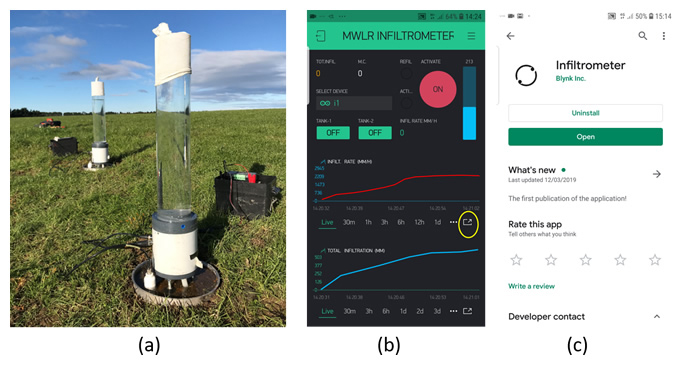Cloud-connected, smartphone-driven infiltrometer network
Storm water generated from a catchment can be appropriately routed if the portion of the rain that contributes to the run-off is properly estimated.
Knowledge of infiltration rates is also important for precision irrigation scheduling, to prevent surface run-off and ensure effective infiltration of irrigation into the plant root zone. Farmers can use resources more efficiently if they are aware of the infiltration rates of the soil types on their farm at a given antecedent moisture content.
The traditional methods of measuring infiltration rates are time consuming and labour intensive. If using the Mariotte bottle method, one would set up the infiltration measurement gear in the field with a sealed water tank that maintains a constant water head. The falling water level in the sealed tank is measured either manually or by a pressure transducer using a data logger. Other methods involve repetitively pouring a standard volume of water into a ring inserted into the soil surface and recording the time to infiltrate, until a steady rate is reached. This method is cumbersome and requires constant attention until the test is completed.
Manaaki Whenua – Landcare Research (MWLR) has developed the automated, cloud-connected, smartphone-driven infiltrometer to measure infiltration rates at any given soil moisture content. Up to five infiltrometers can be networked to measure infiltration rates at five different locations. Since they are connected to the cloud by a cellular network there is no limitation on the distance between devices: they can be set up at various locations and monitored and controlled from one location using a smartphone app.
The design also has significant advantages over the Mariotte bottle design. Our device is not sealed, allowing it to be easily refilled without disturbing the measurement run, and, most importantly, it does not have the air bubbling tube that introduces significant ‘noise’ in the water-level measurements of Mariotte-based devices
The MWLR infiltrometer smart phone app is available on both Google Play and Appstore. After downloading the app, as many as 5 devices can be connected to a single smart phone or tablet by scanning 5 QR codes. Figure 1 shows the interface to monitor the infiltrometer.

Figure 1 (a) MWLR infiltrometer in action in Southland (b) Smart phone interface with real time data visualisation as time series of infiltration rate, total infiltration and moisture content. (c) MWLR smart phone app is available as a free download on Google Play and App Store. Image: Kirstin Deuss
The falling water level in the tank and soil moisture content are recorded over time. Infiltration ring size and the water reservoir sizes can be selected to suit the soil type and can be entered into the smartphone interface and written into data processing in the cloud. This allows smaller rings to be used for clay soil, as the infiltration rate is significantly slower than for sandy soil. Test data are displayed on the smartphone interface as interactive time series charts, which makes it possible to determine when to terminate the test; for example, when the infiltration rate reaches steady state. Time series data are automatically recorded on a cloud database and sent to the user’s email account using the options given in the smartphone interface. Data are also stored on an SD card that can be retrieved from the infiltrometer after field trials are complete.
A spare water tank could be used to refill the water reservoir if it gets low, which is useful for soils that have fissures or are sandy and require a great deal of water before infiltration rates reach steady state. The infiltrometer will detect when the water reservoir level is low and automatically activate the submersible pump to transfer water from the spare tank into the infiltrometer reservoir. The pump will automatically switch off before the water reaches the top. The user will also be notified by a text message when the water level reaches a low level. The water reservoir level, soil moisture content, and battery voltage are displayed on the smartphone interface. The interface also provides the option of adding any field notes for the location in which it is installed; for example, soil and vegetation types or site/location data.
The MWLR infiltrometer therefore provides an effective technological solution to enable significantly improved automated tracking of soil infiltration rates for informing and improving soil water management decisions.


